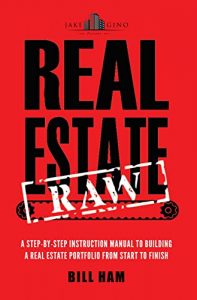How Do You Structure a Seller Financing Deal?
By Bill Ham – Author of Real Estate Raw: A step-by-step instruction manual to building a real estate portfolio from start to finish

- Don’t use current market interest rates to create the interest rate for your seller financing loan. Use a rate that will allow you to cash flow. If you are giving the seller the price they want, you need to have a loan that will let you operate profitably.
- The higher the price…the longer the loan term. You will need time for the property to appreciate before you have to exit (pay the sellers loan off). You will need to sell or refinance the property to pay off the loan. If the property value is down at the point of loan maturity, you will have a distressed exit. The longer the loan term, the less sensitive to the price you will be. If a seller gives you 1 year to pay off a loan… you are very sensitive to the price. If a seller gives you 10 years to pay off a loan, you can be much less sensitive to the price.
- Bring as little cash to the deal as possible. Higher price = lower down payment.
- Defer payments if possible. This is a great way to get a distressed deal renovated and stabilized. Try to get the seller to allow you to defer the first 3-6 months of payments. The interest can be added to the payoff amount at the end of the loan. This will allow you to collect any rent produced by the property and use it to fund renovations.
- Exchange down payment for needed repairs. If the property you are dealing with needs repairs or renovations, exchange down payment for work done to the property.
What is seller financing?
Seller financing is when a seller (of real estate) is willing to sell a property to a buyer by financing the deal for the buyer instead of demanding full payment at the point of sale. In most cases you, the buyer, will obtain a loan to buy a piece of real estate or you will buy it with all cash. Either way the seller receives the full amount of sale price at closing. With seller financing the seller will be creating a mortgage for you (like a bank) and the property will become yours after a closing. The only difference here is that the seller will also be the lender.
What about down payment for seller financing?
The basic structure of seller financing is that the seller will be carrying back a mortgage at closing and they will likely want you to put some money down. How much depends on you, the seller, and the deal. As stated above, try to limit the amount of cash you bring to a deal. My general rule of thumb for down payment is “put down as little as possible but as much as it takes to get the deal done”.
The key aspect to remember when looking to use creative financing is…solve problems for sellers. If your offer is a problem-solving offer, you will increase the likelihood of getting a deal done by 10X! Look for sellers with problems, create a solution to the problem and make an offer that creates value.
About the Author


In 2005 I quit my job as a corporate pilot and went into real estate full-time. I had closed only one deal. A duplex. It was cash flowing about $300 a month. I started my entire real estate carrier with this one duplex and a life savings of $10,000. Not much.
My first 402 units were completed with some form of creative financing such as seller financing and master lease options. Over the years I built a large portfolio of real estate consisting mostly of apartments. I built a management company that operated the portfolio. At the peak that company was comprised of 16 employees and managed over 1000 units.
Over the years I had many successes and many failures. Some small and some big. I have made a lot of money and I have lost a lot of money. I have seen all phases of the market. The up cycles and the down. The good times and the bad. I have survived them all. Knowledge and skills are only passed on by those who survive.
The information I offer you on this site is my own. It has been tried and tested over a long career in the real estate business. Everything here has functionality that you can use, not untested theories. I have been successful with everything I teach. You can be too.















 Accessibility
Accessibility